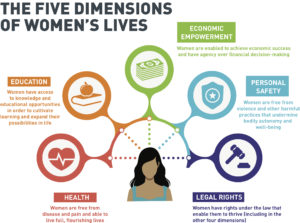Women and girls make up half of the world’s population. Given their roles as caregivers, breadwinners, and de facto community leaders, it is not a surprise that strong data links improvements in the lives of women to improvements in outcomes for families, communities, and global economies.[1] Yet, women around the world experience worse outcomes and have limited opportunities compared to men in many areas of life.[2] Improving women’s lives is therefore both a matter of social justice and smart investment for broad social impact.
There are a multitude of ways that donors can help to improve the lives of women and girls. But it can be a daunting task sifting through data and information to identify those efforts that have the greatest potential for social impact. The Center for High Impact Philanthropy’s mission is to use evidence-based analysis to identify the most promising solutions for addressing a social challenge and maximizing the social impact return of philanthropic funds. In this report, we provide a comprehensive framework for those interested in advancing the lives of women and girls.
To be sure, trying to improve the lives of half of the world’s population is a lofty task given the differences in the economic and social conditions of women around the globe. To rein in this enormous topic, our team examined dozens of research studies and related frameworks, sorting through the thousands of indicators that are being used by development institutions, policymakers, foundations, community agencies, and other stakeholders concerned about making a difference in the lives of women and girls.[3] What emerged from the evidence was consensus around which indicators link to the greatest impact on the lives of women and girls globally, in five key areas: health, education, economic empowerment, personal safety, and legal rights.
We call these the “five dimensions of women’s lives.” They represent what we believe to be vital areas where funders can create positive change. For each dimension we highlight which indicators have both the deepest evidence base and the broadest consensus linking them to greater social impact for women and girls globally. We created this framework to help funders:
- Understand the main ways to help
- Identify the most promising and evidence-based areas of intervention; and
- Measure progress.
The results of this effort were eye opening. For one, the topic of improving the lives of women and girls had no existing comprehensive framework. Nor could we explain why certain sectors, such as education and mental health, were excluded—or simply subsumed—under broader health and economic headings, despite the overwhelming research evidence of their significance.
Our hope is that this report will help philanthropists of all kinds work more effectively and efficiently to enhance the lives of women and girls. Given how vast this topic can seem, there is a tendency to choose one area of particular interest, without recognizing the interconnectedness to other areas that may matter too. This overly silo-ed approach can prevent funders from identifying others doing similar or complementary work. We offer this report in the hope that anyone interested in promoting the lives of women and girls may now have one comprehensive playbook—and that it leads to a larger understanding of how the various efforts highlighted can contribute to the larger shared goal.

Endnotes
[1] United Nations. “Investing in Women and Girls.” 2008. https://www.un.org/es/events/women/iwd/2008/IWDma08.pdf.
[2] World Economic Forum. “The Global Gender Gap Report 2016.” Journal of Family Issues. Vol. 25. Geneva, Switzerland, 2004. http://www3.weforum.org/docs/GGGR16/WEF_Global_Gender_Gap_Report_2016.pdf.
[3] Thousands of indicators are being used by development institutions like the United Nations (UN) and Organization for Economic Cooperation and Development (OECD), nonprofits like Oxfam and the Gates Foundation, and others concerned about improvements in the lives of women. For example, the World Bank has hundreds of indicators in their gender data portal just to measure “economic opportunities” for men and women. For more information, see http://datatopics.worldbank.org/gender/indicators.
